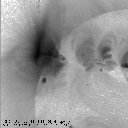

When we run a movie of this event (below), we see that not only is there structure above the arcade, there's motion. The movie is made about one-and-a-half hours after the movies from the previous Nugget. This is during the decay phase of the flare. The flare decay phase is often thought of as uninteresting, precisely because there are no motions or changes in morphology.
|
(173 kbyte) |
(418 kbyte) |
The flow is detectable because of the movement of the dark "blob-like" features in the images. Note that these features are moving downwards, into the top of the arcade. The speeds are between 100-500 km/sec (200 thousand to 1 million mph), and the dark (in X-rays) features are about 10 thousand kilometers in diameter.
First, this flare (and many others like it) was associated with a coronal mass ejection (CME), in which great quantities of material is cast off (or escapes) from the Sun. If some of this material failed to achieve escape velocity (620 km/sec), then it would have to fall back to the surface of the Sun. The downward speed would also be less than 620 km/sec, which is consistent with the observations here. Note that the material would almost certainly not be dense enough to "block out" X-rays; to create the dark appearance we see here, the cool blobs would have to push the hotter, X-ray emitting material out of the way.
Second, the motion could represent the shrinkage of magnetic field lines that have been reconnected as a result of the CME. In the standard picture of the formation of post-CME arcades, the magnetic field which is stretched out by the eruption reconnects underneath the ejected material. Having reconnected, the field lines then shrink back down from their higher, stretched-out state to a more relaxed configuration -- forming the arcade of loops in the process. The motion seen above the arcade might be interpreted as this "shrinkage". If it helps, a cartoon depicting this shrinkage scenario is sketched below.

And if the second interpretation above can be demonstrated to be accurate, then we have gained a few implications for reconnection models (and maybe some challenges for the modelers!). First, the speeds of 45-500 km/sec are somewhat slower than typically expected for reconnection outflows, though Forbes and Acton (1996) point out that the speed can be affected by the plasma conditions. Second, the flows are discrete along the length of the arcade; this points to a patchy and intermittent kind of truly 3-D reconnection (a la Klimchuk 1997). Finally, what are the rays that poke up from the top of the arcade? Svestka et al. (1998) thought they might be mini-jets, but we haven't yet found any indication of outward flow in the area above the arcade. We know they're hot, at least 5 million kelvins and maybe as hot as 15 MK.
References:
Forbes, T., and Acton, L. 1996, ApJ, 459, 330
Klimchuk, J. 1997, in ASP Conf. Ser. 111: Magnetic Reconnection in the
Solar Atmosphere, ed. R. Bentley and J. Mariska, 319
McKenzie, D., and Hudson, H. 1999, ApJ, 519, L93
Svestka, Z., Farnik, F., Hudson, H., and Hick, P. 1998, Sol. Phys., 182,
179
22-January-2000
D. McKenzie (mckenzie@isass0.solar.isas.ac.jp)